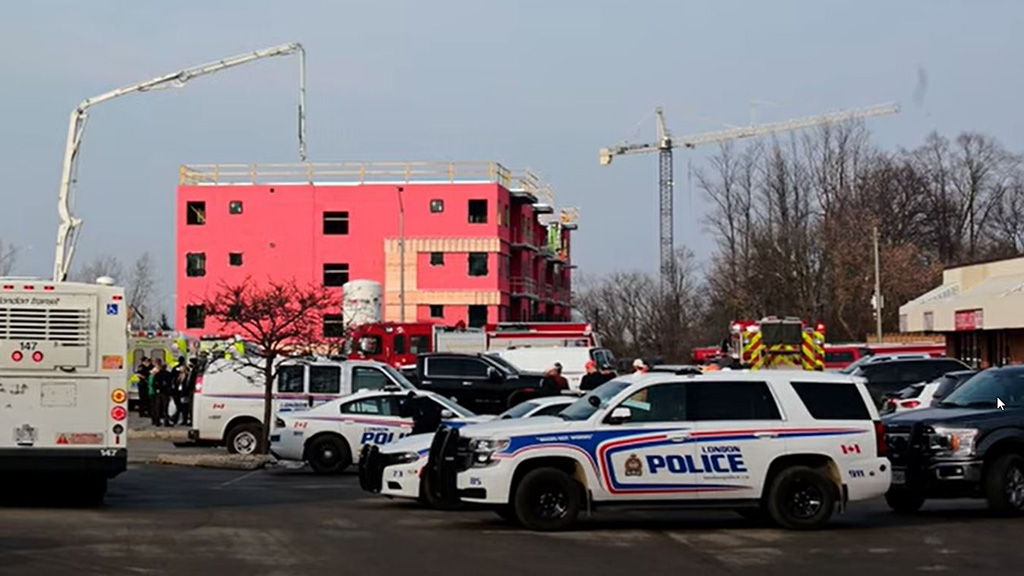Workplace safety advocates say they are frustrated by the sentences handed down by the Ontario Court of Justice in London, Ont. recently after two Oxford County contractors pleaded guilty to health and safety violations causing two deaths on a London jobsite.
Construction workers John Martens of Langton, Ont. and Henry Harder of Tillsonburg, Ont. died after the partial collapse of a low-rise residential building under construction on Wonderland Road in London on Dec. 11, 2020. The collapse occurred during a fourth-floor roof-level concrete pour. Four other workers suffered critical injuries.
Following guilty pleas on Dec. 15, 2023 iSpan Systems LP was fined $260,000 and East Elgin Concrete Forming Ltd. was fined $140,000 by Justice Michael Carnegie. iSpan was determined to have failed to ensure the structure was capable of supporting the concrete load that was poured and East Elgin was found to have failed to provide proper supervision during the measurement of the concrete on the project, in both cases contrary to the Occupational Health and Safety Act.
The court heard East Elgin used a laser level and directed the subcontractor to pour to the height of the laser level. Workers believed the concrete depth was insufficient at certain locations in the pour and so more concrete was applied than had been specified by iSpan.
Engineering analysis determined the concrete placed exceeded the design values by “considerable amounts,” leading to or contributing to the severity of the collapse.
Martens was 21 and Harder 26 when the incident occurred. Harder had just become the father of a baby girl. Both workers were employees of East Elgin.
Neither employer responded to requests for a statement. iSpan applied for bankruptcy protection in 2022.

Among the victims of the incident was Jacob Hurl, then a labourer who was working on the first floor. Tonnes of debris fell on him during the collapse, and he suffered numerous injuries – a concussion, broken vertebra, blood clots in his lungs, a gash on his head, and others including a broken left femur and hip, with the leg injuries so extensive he barely escaped amputation.
Hurl has been taking programs towards recovery supported by the WSIB and in the spring expects to graduate from George Brown College with a diploma in project management.
“I was happy being a construction worker and all I ever wanted to do in my life is do that,” said Hurl. “Now it’s to the point where I don’t think I’m physically capable of working an eight to 12 hour shift doing that hard labour. So my life has been affected by that.”
The Lucan, Ont. resident says he aims to begin an active life in advocacy, reaching out to fellow injured workers through videos and podcasts.
Hurl has multiple grievances related to his experiences on the job and in recovery. He was never approached as a victim for input into the sentencing or to give a victim-impact statement; he is disappointed there were not maximum fines in an incident as catastrophic as the Wonderland Road collapse; and he says he can’t believe it is still legal in Ontario to pour concrete on jobsites with employees working underneath.
Hurl wrote on Facebook, “Fines laid against the two negligent companies that laid two great young men in the ground and injured three workers and myself, changed our lives and families lives forever. A three-year-old little girl will never know her dad.”
Hurl noted maximum fines are now $1.5 million.
“It should be maximum fines for these companies. Because if this event doesn’t get maximum fines, then tell me what does?”
“When workers die, there’s never a fair fine,” added Carmine Tiano, director of occupational services for the Ontario Building Trades.
“Should it have been higher? Absolutely, 100 per cent. But the fine in and of itself is not going to make the change. We need for employers to understand that it is very, very important that they take health and safety seriously.”
Ontario Federation of Labour president Laura Walton called the sentences “disappointing” and said they would not serve as a deterrent to other unsafe employers.
“What’s really disappointing to me is these are families that are impacted. These are workers that are impacted,” she said. “And really, the employer, the companies are getting off essentially Scot-free.”
Given the multiple deaths and the circumstances, Walton wondered why criminal charges were not laid. The 2004 federal Westray law provided new rules for attributing criminal liability to corporations and managers for workplace violations that result in injuries or death.
Tiano suggested a 2020 decision, the Ministry of Labour vs. Vixman Construction, offers a sentencing alternative to mere high fines. In that case, the parties agreed “creative sentencing” that required an offender to participate in producing a video and writing a published article, among other obligations, could offer deterrence, protect the public, help with victim rehabilitation and keep safety violations in the public eye beyond the one-day news cycle.
“It needs to be built into their economic viability as a company,” said Tiano. “The smartest thing we should be doing is in addition to that fine and charging to the max, maybe we need to be looking at the idea of implementing creative sentencing.”
Walton said the sentences presents a moment for advocates to ask for legislative change.
“We need the government to recognize this is not acceptable. We need the community to understand this is not acceptable,” she said.
“This is a government in Ontario that claims that they’re working for workers.”
The ministry declined comment on the sentencing.











Recent Comments
comments for this post are closed